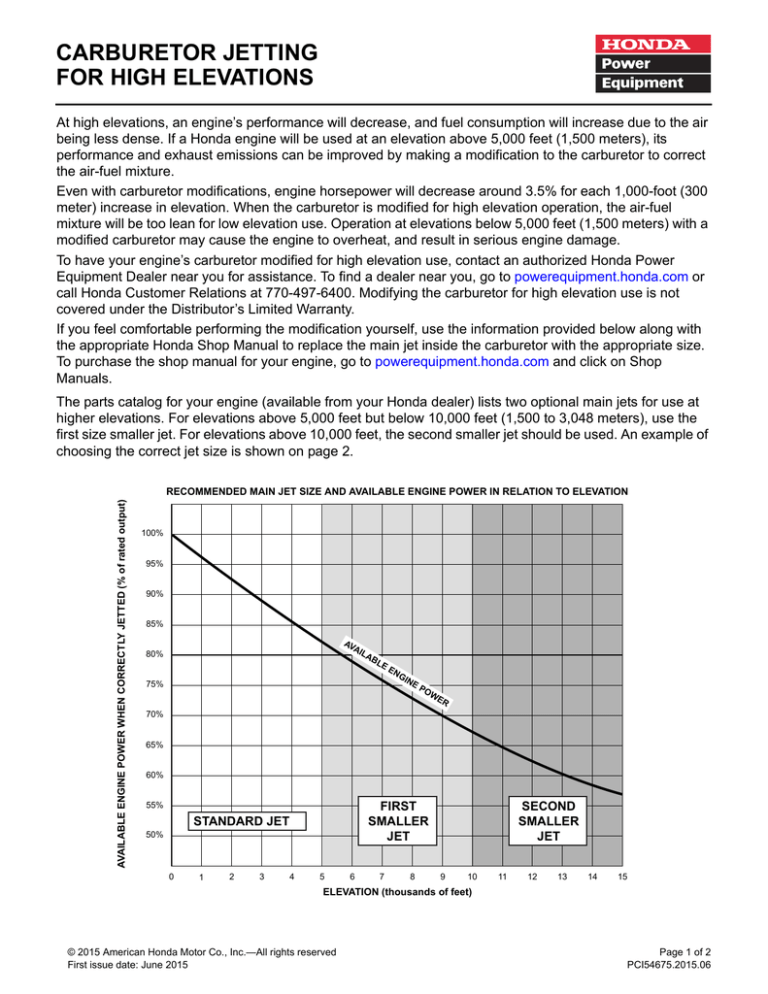
CARBURETOR JETTING
FOR HIGH ELEVATIONS
At high elevations, an engine’s performance will decrease, and fuel consumption will increase due to the air
being less dense. If a Honda engine will be used at an elevation above 5,000 feet (1,500 meters), its
performance and exhaust emissions can be improved by making a modification to the carburetor to correct
the air-fuel mixture.
Even with carburetor modifications, engine horsepower will decrease around 3.5% for each 1,000-foot (300
meter) increase in elevation. When the carburetor is modified for high elevation operation, the air-fuel
mixture will be too lean for low elevation use. Operation at elevations below 5,000 feet (1,500 meters) with a
modified carburetor may cause the engine to overheat, and result in serious engine damage.
To have your engine’s carburetor modified for high elevation use, contact an authorized Honda Power
Equipment Dealer near you for assistance. To find a dealer near you, go to powerequipment.honda.com or
call Honda Customer Relations at 770-497-6400. Modifying the carburetor for high elevation use is not
covered under the Distributor’s Limited Warranty.
If you feel comfortable performing the modification yourself, use the information provided below along with
the appropriate Honda Shop Manual to replace the main jet inside the carburetor with the appropriate size.
To purchase the shop manual for your engine, go to powerequipment.honda.com and click on Shop
Manuals.
The parts catalog for your engine (available from your Honda dealer) lists two optional main jets for use at
higher elevations. For elevations above 5,000 feet but below 10,000 feet (1,500 to 3,048 meters), use the
first size smaller jet. For elevations above 10,000 feet, the second smaller jet should be used. An example of
choosing the correct jet size is shown on page 2.
AVAILABLE ENGINE POWER WHEN CORRECTLY JETTED (% of rated output)
RECOMMENDED MAIN JET SIZE AND AVAILABLE ENGINE POWER IN RELATION TO ELEVATION
100%
95%
90%
85%
AV
AI
80%
LA
BL
EE
75%
NG
IN
EP
OW
ER
70%
65%
60%
FIRST
SMALLER
JET
55%
STANDARD JET
50%
0
1
2
3
4
5
6
7
8
SECOND
SMALLER
JET
9
10
11
12
13
14
15
ELEVATION (thousands of feet)
© 2015 American Honda Motor Co., Inc.—All rights reserved
First issue date: June 2015
Page 1 of 2
PCI54675.2015.06
Example:
The Honda EU2000i generator uses a 0.62 mm main jet (#62) as the standard size. The two options listed are a
0.60 mm (#60) and 0.58 mm (#58) jet. The owner wants to operate this generator at 7,200 feet for an extended period.
On the elevation scale at the bottom of the chart, select 7,200 feet (between 7 and 8 on the scale). You can see that
elevation falls in the light gray band for “first smaller jet.” Consequently, the correct jet size is 0.60 mm (#60).
The rest of the chart is just for approximating what percentage of sea-level horsepower will be produced by a
correctly-jetted engine at higher elevations. At 7,200 feet, an engine will produce about 75% of its rated horsepower.
AVAILABLE ENGINE POWER WHEN CORRECTLY JETTED (% of rated output)
RECOMMENDED MAIN JET SIZE AND AVAILABLE ENGINE POWER IN RELATION TO ELEVATION
100%
95%
90%
85%
AV
AI
80%
LA
BL
EE
75%
NG
IN
EP
OW
ER
70%
65%
60%
FIRST
SMALLER
JET
55%
STANDARD JET
50%
0
1
2
3
4
5
6
7
8
SECOND
SMALLER
JET
9
10
11
12
13
14
15
ELEVATION (thousands of feet)
Tip:
Put a small label somewhere on the product indicating that the
carburetor has been re-jetted. This will help remind you which
jet is currently installed in the carburetor.
© 2015 American Honda Motor Co., Inc.—All rights reserved
First issue date: June 2015
Page 2 of 2
PCI54675.2015.06


